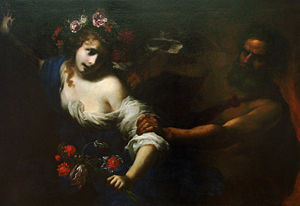
Simone Pignoni
Encyclopedia

Italy
Italy , officially the Italian Republic languages]] under the European Charter for Regional or Minority Languages. In each of these, Italy's official name is as follows:;;;;;;;;), is a unitary parliamentary republic in South-Central Europe. To the north it borders France, Switzerland, Austria and...
painter of the Baroque
Baroque
The Baroque is a period and the style that used exaggerated motion and clear, easily interpreted detail to produce drama, tension, exuberance, and grandeur in sculpture, painting, literature, dance, and music...
period.
He apprenticed with Fabrizio Boschi
Fabrizio Boschi
Fabrizio Boschi was an Italian painter of the early-Baroque period, active in Florence.He is said to have been a pupil of Domenico Passignano...
, then with the more academic and puritanical Domenico Passignano
Domenico Passignano
Domenico Passignano , born Cresti or Crespi, was an Italian painter of a late-Renaissance or Contra-Maniera style that emerged in Florence towards the end of the 16th century.- Biography :...
, and finally with Francesco Furini
Francesco Furini
Francesco Furini was an Italian Baroque painter of Florence.His early training was by Matteo Rosselli , though Furini is also described as influenced by Domenico Passignano and Giovanni Biliverti . He befriended Giovanni da San Giovanni...
. He is best known for painting in a style reminiscent of the morbidly sensual Furini. Reflective of this obsession is his self-portrait, c. 1650, in which he depicts himself building up a plump naked female from a skeleton. The biographer Baldinucci
Filippo Baldinucci
Filippo Baldinucci was an Italian art historian and biographer.-Life:Baldinucci is considered among the most significant Florentine biographers/historians of the artists and the arts of the Baroque period...
, in what little he notes of the painter, recalls him as the scandalous imitator of (Furini's) licentious inventions.
A more complete biography was recorded by his pupil Giovanni Camillo Sagrestani
Giovanni Camillo Sagrestani
Giovanni Camillo Sagrestani was an Italian painter of the Baroque era.A native of Florence, he was a follower of the style of Carlo Cignani. His major pupil was Matteo Bonechi and Giovanni Battista Ranieri del Pace. Four canvases attributed to Sagrestani can be found in the church of Santa Maria...
. Described as endowed with a bizarre and amenable intelligence, Pignoni apparently had a late-life conversion to more pious painting. There is one episode recalled that during a serious illness because in his life he had focused on studying about female forms, and (now) having resigned himself to the impending infinity, his spiritual father urged him to purge those errors with the flame, and once guided by a good disposition, he suddenly was cured by the Lord. It must be noted that Baldinucci's biography of Furini, also recorded a similar, near-death renunciation of his art of the naked figure.
Among his more conventional works are a St. Agatha cured by St. Peter (attributed) in the Museo Civico di Trieste
Trieste
Trieste is a city and seaport in northeastern Italy. It is situated towards the end of a narrow strip of land lying between the Adriatic Sea and Italy's border with Slovenia, which lies almost immediately south and east of the city...
. A St. Louis providing a banquet for the poor (c. 1682) now in the church of Santa Felicita in Florence
Santa Felicita di Firenze
Santa Felicita is a church in Florence, Italy, probably the oldest in the city after San Lorenzo. In the 2nd century, Syrian Greek merchants settled in the area south of the Arno and are thought to have brought Christianity to the region...
, commissioned by Conte Luigi Gucciardini. A Madonna and child in glory with archangels Saints Michael and Raphael in battle armor and San Antonio of Padua (1671) for the Cappella di San Michele in Santissima Annunziata
Basilica della Santissima Annunziata di Firenze
The Basilica della Santissima Annunziata is a Roman Catholic minor basilica in Florence, Italy, the mother church of the Servite order. It is located at the northeastern side of the Piazza Santissima Annunziata....
. He painted an Allegory of Peace in Palazzo Vecchio
Palazzo Vecchio
The Palazzo Vecchio is the town hall of Florence, Italy. This massive, Romanesque, crenellated fortress-palace is among the most impressive town halls of Tuscany...
. A Penitent Magdalen has been attributed to Pignoni is found in the Pitti Palace. In San Bartolomeo in Monteoliveto, he painted a Madonna appearing to Blessed Bernardo Tolomeo.

